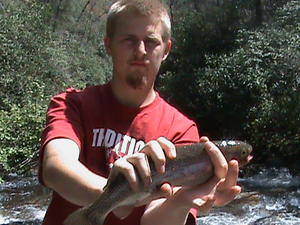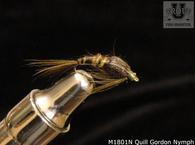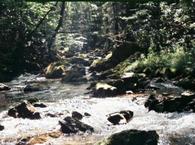
When conditions are great, catching trout from fast moving freestone, headwater streams anywhere in the nation, isn't difficult. However, consistently catching plenty of trout under both cold and high water conditions can present a challenge. Unlike what many novice anglers think, the difficulty of catching trout under adverse conditions has very little to do with the trout. It has everything to do with your ability to present
them something they will take for food at the right place, at the right time, and in a natural manner. Wild trout must eat each and every day of their life and rarely get enough food.
For the trout to survive when the water temperature is 42 degrees, the trout will be holding in holes and other places out of the current but they will still need to eat. It will be necessary to present a fly right in front of their nose and it must be moving at the same speed as the natural nymphs and larvae. Also often times the trout will be holding in areas underneath fast to moderately moving water and getting the fly to move slowly on the bottom like a natural would be moving is very difficult.
Another consideration is that flies are clearly visible to the trout when they are moving slowly and drifting right up to the trout’s nose. Under these conditions, the trout are not gobbling up something that they see only for a split second. On the contrary, they must be willing to eat something they can clearly see. Indeed, they see real aquatic insect nymphs and larvae day in and day out for their entire life. Therefore, it make sense that a fly that resembles the things they see day in and day out is more likely to be eaten than one that doesn't? We at the Troutprostore strongly recommends our line of Flies as they are the best imitation of the aquatic insects available today.
Maintaining constant control over the drift of the fly under these circumstances isn't easy. That's why an almost vertical presentation, usually called high sticking, keeps most of the fly line out of the current and helps one control the speed of the drift. Having this type of direct contact with the fly also helps one detect strikes





